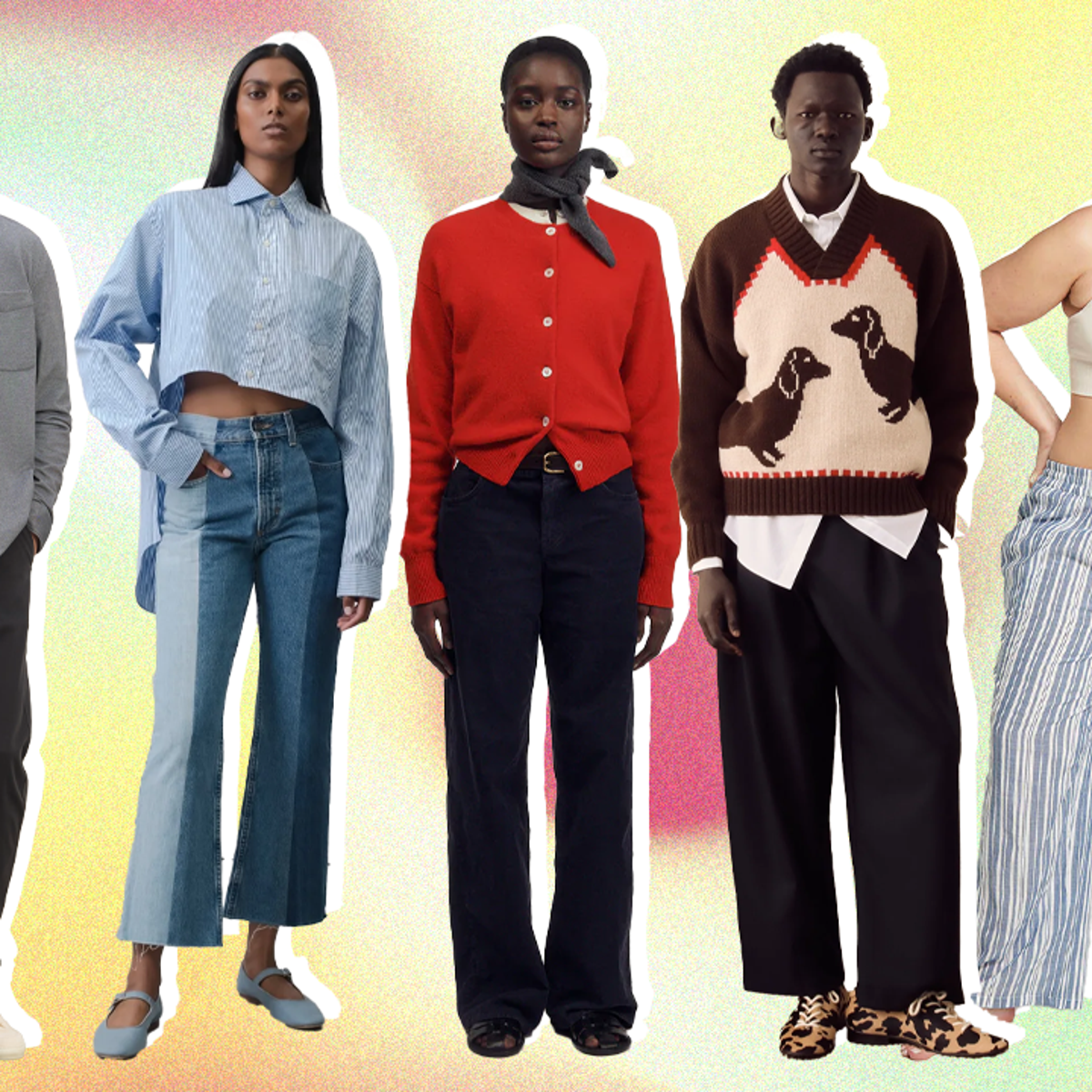Fabric Fit Guide: How to Pick Branded Clothing That Moves With You
Understanding Garments: The Relevance of Textile Selections in Your Closet
The choice of fabric in apparel plays a critical duty in both aesthetic appeals and capability. Different products use varying degrees of convenience, breathability, and resilience, straight influencing the wearer's experience. Comprehending these nuances can improve one's wardrobe substantially. Yet, numerous neglect just how these options can impact not simply personal style, yet also sustainability. What fabric choices could redefine your closet and align it with both style and responsibility?
The Function of Fabric in Style and Capability

Usual Material Types and Their Features
When picking clothing, recognizing the attributes of typical material types is crucial for making educated selections. Cotton, a widely-used natural fiber, is understood for its adaptability, breathability, and softness, making it appropriate for sportswear and day-to-day garments. Bed linen, one more all-natural alternative, boasts outstanding moisture-wicking residential or commercial properties and a distinct structure, ideal for cozy climates.Wool, often favored for its heat and sturdiness, differs in excellence; merino woollen is soft against the skin, while coarser types are used for outerwear. Synthetic textiles like polyester and nylon use longevity and resistance to wrinkles, making them preferred for activewear and traveling garments. Blends, which integrate synthetic and natural fibers, can boost functionality while maintaining convenience. By acknowledging these material qualities, people can select clothing that straightens with their way of living and visual preferences.
Breathability and Comfort: Picking the Right Fabrics for Different Environments
Selecting the best fabrics for various climates can significantly improve comfort and total wearability. Breathable products are important in warm environments, as they permit air blood circulation and moisture dissipation. Fabrics such as cotton, bed linen, and moisture-wicking synthetics properly draw sweat away from the body, maintaining the user cool and dry. Alternatively, in chillier environments, thicker materials like woollen or fleece supply insulation while maintaining breathability, making sure heat without overheating.Additionally, the choice of fabric weight plays an important function; lightweight fabrics are more effective for summertime, whereas larger alternatives are matched for winter season wear. Recognizing the distinct homes of each material makes it possible for people to clothe properly for varying weather. Ultimately, choosing breathable and comfortable textiles tailored to certain climates can significantly boost day-to-day comfort and enhance the total experience of using apparel.
Toughness and Care: Just How Fabric Affects Long Life of Your Wardrobe
Picking the best products can greatly influence the longevity and treatment requirements of a wardrobe. Fabrics such as cotton and polyester are recognized for their resilience and convenience of upkeep, making them perfect for day-to-day wear. On the other hand, fragile materials like silk and lace need even more careful handling and specialized cleansing methods, which can raise the moment and effort required for care. Branded Clothing.Durability is likewise influenced by the fabric's weave and finish; securely woven textiles have a tendency to resist deterioration better than loosely woven choices. Furthermore, synthetic blends typically supply enhanced resilience, incorporating the very best top qualities of several fibers.Understanding the care guidelines for every material is essential, as incorrect drying out or washing can cause premature wear. Eventually, picking durable materials can cause a longer-lasting wardrobe, reducing the frequency of substitutes and contributing to a more lasting fashion option
The Effect of Fabric on Fit and Silhouette

Lasting Fabric Choices: Making Eco-Friendly Decisions
The influence of material extends past fit and shape to encompass ecological factors, prompting a growing rate of interest in sustainable fabric choices. Environmentally friendly textiles, such as natural cotton, hemp, and Tencel, are getting traction among customers who prioritize sustainability in their wardrobes. These materials are usually generated with fewer chemicals and water, reducing their eco-friendly footprint.Additionally, recycled fabrics, made from post-consumer waste, offer a cutting-edge option to the textile market's pollution problem. Brands significantly embrace openness in their sourcing approaches, enabling customers to make informed choices regarding their purchases.Choosing lasting fabrics not just supports ethical techniques but additionally encourages the garment industry to embrace even more liable production approaches. As awareness of ecological concerns climbs, people are prompted to show on the long-lasting effect of their material choices, cultivating a motion towards a much more ecologically conscious and lasting method to fashion.
Raising Style: Just How Fabric Can Change a Clothing
While several might concentrate on color and cut when selecting an outfit, the selection of fabric plays an essential role in raising style and enhancing general appearance. Various materials communicate distinctive state of minds and messages; for instance, silk radiates deluxe and refinement, while denim offers a casual, relaxed ambiance. The structure and drape of a fabric can dramatically modify the silhouette, with organized materials giving a polished appearance and softer ones creating a more fluid, kicked back aesthetic.Moreover, the weight of the material affects wearability throughout seasons. Lightweight fabrics like linen and cotton are optimal for summertime, while much heavier products such as woollen and velour supply warmth and style in chillier months. Recognizing material residential or commercial properties, such as breathability and stretch, also Clicking Here empowers people to make educated choices that improve comfort without jeopardizing design. Inevitably, the appropriate material can transform an outfit from regular to amazing, making it a crucial factor to consider in any kind of wardrobe.
Often Asked Inquiries
Exactly how Do I Determine the Fabric Content of My Clothes?
To recognize textile content, one can analyze treatment tags, conduct melt tests for fiber identification, or get in touch with fabric swatches. These methods help set apart materials, ensuring notified selections for clothing treatment and maintenance in everyday wear.
Can Material Choice Affect My State Of Mind or Self-confidence?
Textile choice can considerably affect a person's mood and self-confidence. Branded Clothing. Specific materials might stimulate sensations of convenience or style, while others can feel unflattering or restrictive, eventually affecting self-perception and emotional wellness throughout the day
What Fabrics Are Ideal for Sensitive Skin?
For individuals with delicate skin, all-natural materials like linen, cotton, and bamboo are typically suggested. These products are breathable, hypoallergenic, and less most likely to trigger irritation, making them suitable selections for convenience and skin health and wellness.
Just how Do I Correctly Clean and Take Care Of Various Fabrics?
To properly care and clean for various fabrics, one must consider each product's specific needs, including temperature level setups, cleaning agents, and drying techniques, making certain long life and maintaining the fabric's initial top qualities for excellent usage.
Exist Details Fabrics for Athletic or Performance Use?
Sports or performance wear typically utilizes materials such as nylon, polyester, and spandex. These materials are designed for moisture-wicking, breathability, and versatility, boosting movement and comfort throughout exercises while giving durability and assistance. On the other hand, in chillier climates, thicker materials like woollen or fleece supply insulation while maintaining breathability, making certain warmth without overheating.Additionally, the choice of textile weight plays an essential role; lightweight materials are more suitable for summer season, whereas much heavier choices are matched for winter wear. In contrast, delicate materials like silk and shoelace require more careful handling and specialized cleansing methods, which can raise the time and effort needed for care.Durability is also affected by the textile's weave and finish; securely woven materials often tend to resist wear and tear far better than freely woven options. In contrast, inflexible textiles can restrict activity however give a timeless, refined look.Moreover, the thickness and appearance of the material can affect the visual understanding of body shape. The effect of material prolongs past fit and silhouette to encompass environmental aspects, triggering an expanding passion in sustainable textile selections. The structure and drape of a material can drastically change the shape, with organized materials providing a sleek appearance and softer ones producing an extra fluid, loosened up aesthetic.Moreover, the weight of the textile affects wearability across periods.